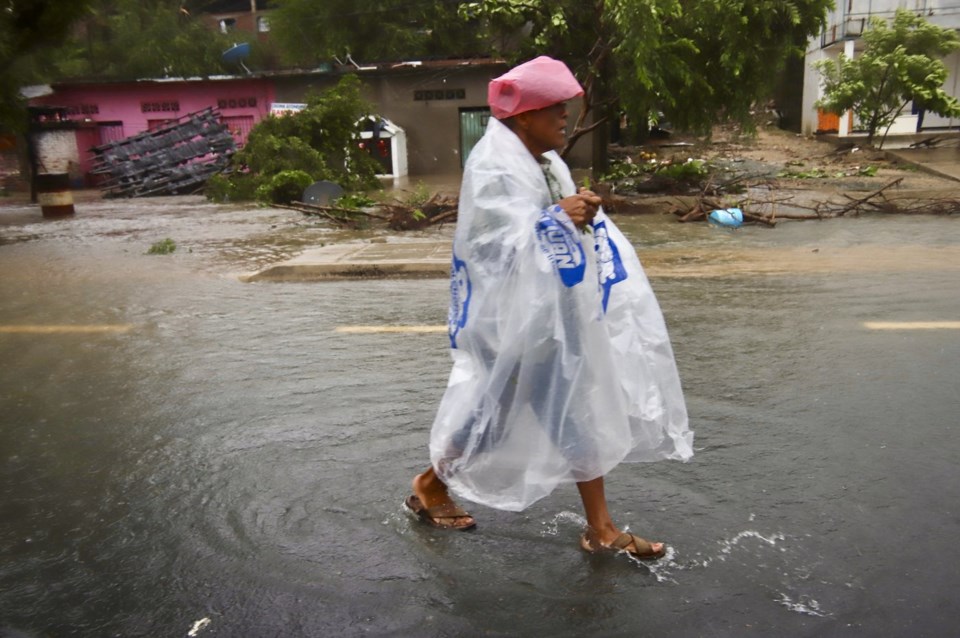MARQUELIA, Mexico (AP) — Former Hurricane John dissipated over Mexico on Tuesday after barreling into the country’s southern Pacific coast overnight, leaving two dead and a trail of destruction in its path.
Currently a tropical depression, John was 70 miles (115 kilometers) northwest of Acapulco and moving northwest at 3 mph (6 kph) as it dawdled along the coastal mountains and continued to weaken.
John grew into a Category 3 hurricane in a matter of hours Monday and made landfall about 80 miles (130 kilometers) east of the resort of Acapulco, near the town of Punta Maldonado, with maximum sustained winds of 120 mph (190 kph) before declining to a tropical storm after moving inland. It was downgraded on Tuesday to remnants with maximum sustained wind speeds of 35 mph (55 kph), the U.S. National Hurricane Center said. Mexican authorities discontinued all tropical storm warnings.
It blew tin roofs off houses, triggered mudslides and toppled scores of trees, officials said Tuesday.
Evelyn Salgado, the governor of the coastal state of Guerrero, said two people died when the storm sent a mudslide crashing into their house on the remote mountain of Tlacoachistlahuaca (TLAH-ko-chis-tla-waka), further from the coast.
After warning that the potentially catastrophic flash flooding and mudslides in some Mexican states, the U.S. National Hurricane Center said the main concern on Tuesday morning was flash flooding in parts of southern and southwestern Mexico in the coming days.
Lincer Casiano Clemente, the mayor of the town of Marquelia, near where the hurricane hit on the coast, said early Tuesday that “there are a lot of houses, mainly the ones with sheet roofing, where the force of the air blew off the roofing.”
The mayor said no deaths or injuries had been reported in Marquelia so far, something he attributed to his ability to warn residents of the storm's approach. But power was knocked out along large parts of the coast, and highways were blocked by fallen trees. The government said some 60,000 people remained without power.
“We've never seen such strong gusts,” the mayor said. By Tuesday morning, people were out looking for food, he said.
Monday's unexpected surge in strength caught scientists, authorities and residents of the area by surprise, something AccuWeather Senior Meteorologist Matt Benz attributed to warmer oceans, which add fuel to hurricanes.
As a result, surprise surges in hurricanes' strength have become increasingly common, Benz said.
“These are storms that we haven’t really experienced before,” he said. “Rapid intensification has occurred more frequently in modern times as opposed to back in the historical record. So that’s telling us there’s something going on there.”
Mexican President Andrés Manuel López Obrador warned residents of the area to be vigilant on Monday night and to bunker down in a safe place.
“Seek higher ground, protect yourselves and do not forget that life is the most important thing; material things can be replaced. We are here,” López Obrador wrote on the social media platform X.
The storm is bleak news for the region, which was walloped by Otis, a similar rapidly intensifying hurricane, in 2023.
Otis devastated the resort city of Acapulco, where residents had little warning of the strength of what was about to hit them. One of the most rapidly intensifying hurricanes ever seen, scientists at the time said it was a product of changing climate conditions.
Otis blew out power in the city for days, leaving bodies scattered on the coast and desperate family members searching for lost loved ones. Much of the city was left in a state of lawlessness and thousands scavenged in stores, scrambled for food and water.
The government of López Obrador received harsh criticism for its slow response to Otis, but authorities have since pledged to pick up their speed. Oaxaca and other parts of the Pacific coast seemed to have avoided the devastation witnessed last year in Acapulco.
President-elect Claudia Sheinbaum said her government planned to work on improving an early alert system, similar to what the country has with earthquakes.
___
AP writer María Verza in Mexico City contributed to this report. Follow AP’s coverage of Latin America and the Caribbean at https://apnews.com/hub/latin-america
Luis Alberto Cruz, The Associated Press



